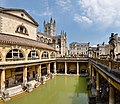Thermae
Thermae
Thermae, also known as ancient Roman baths, were public bathing complexes that played a significant role in the social and cultural life of ancient Rome. These bathhouses were not only places for personal hygiene but also served as centers for socializing, relaxation, and even conducting business. This article explores the history, architecture, and cultural significance of thermae in ancient Rome.
History[edit]
The concept of public bathing dates back to ancient Greece, but it was the Romans who popularized and perfected the idea. The earliest known thermae in Rome were built during the Republican period, with the first public bathhouse, the Baths of Agrippa, constructed in 25 BC. However, it was during the Imperial period that thermae reached their peak in terms of size, grandeur, and popularity.
Architecture[edit]
Thermae were typically large, multi-functional complexes that consisted of various rooms and facilities. The main features of a typical Roman bathhouse included:
1. **Frigidarium**: This was the cold room, where bathers would start their bathing experience. It usually contained a cold plunge pool or a cold-water basin.
2. **Tepidarium**: The tepidarium was a warm room with a moderate temperature. It served as a transition space between the frigidarium and the caldarium.
3. **Caldarium**: The caldarium was the hot room, where bathers would enjoy hot baths and steam. It often featured a hot-water pool or a steam room.
4. **Natatio**: The natatio was an open-air swimming pool, which was sometimes included in larger and more luxurious bath complexes.
5. **Apodyterium**: This was the changing room, where bathers would undress and store their belongings.
6. **Palaestra**: The palaestra was an exercise area, often located outside the main bathhouse building. It was used for various physical activities, including wrestling, running, and ball games.
Cultural Significance[edit]
Thermae played a crucial role in Roman society and culture. They were not only places for personal hygiene but also served as social hubs where people from all walks of life could gather and interact. The bathhouses provided an opportunity for Romans to relax, exercise, and engage in intellectual discussions. They were also important venues for conducting business and political discussions.
The popularity of thermae extended beyond the Roman elite, as even the lower classes could afford to visit the public bathhouses. The Roman government recognized the importance of thermae in promoting social cohesion and provided free or subsidized access to the bathhouses for the general public.
Legacy[edit]
The influence of Roman thermae can still be seen in modern-day bathing practices. The concept of public bathing, as well as the architectural elements of Roman bathhouses, have been adopted and adapted by various cultures throughout history.
See Also[edit]
References[edit]
1. Smith, R.R.R. (2015). "The Roman Bath in Britain: An Architectural History." The History Press. 2. Claridge, A. (2010). "Rome: An Oxford Archaeological Guide." Oxford University Press.
-
Thermae
-
Thermae
-
Thermae
-
Thermae
-
Thermae
-
Thermae
-
Thermae
-
Thermae
-
Thermae
-
Thermae
-
Thermae
-
Thermae
Ad. Transform your life with W8MD's Budget GLP-1 injections from $75


W8MD offers a medical weight loss program to lose weight in Philadelphia. Our physician-supervised medical weight loss provides:
- Weight loss injections in NYC (generic and brand names):
- Zepbound / Mounjaro, Wegovy / Ozempic, Saxenda
- Most insurances accepted or discounted self-pay rates. We will obtain insurance prior authorizations if needed.
- Generic GLP1 weight loss injections from $75 for the starting dose.
- Also offer prescription weight loss medications including Phentermine, Qsymia, Diethylpropion, Contrave etc.
NYC weight loss doctor appointmentsNYC weight loss doctor appointments
Start your NYC weight loss journey today at our NYC medical weight loss and Philadelphia medical weight loss clinics.
- Call 718-946-5500 to lose weight in NYC or for medical weight loss in Philadelphia 215-676-2334.
- Tags:NYC medical weight loss, Philadelphia lose weight Zepbound NYC, Budget GLP1 weight loss injections, Wegovy Philadelphia, Wegovy NYC, Philadelphia medical weight loss, Brookly weight loss and Wegovy NYC
|
WikiMD's Wellness Encyclopedia |
| Let Food Be Thy Medicine Medicine Thy Food - Hippocrates |
Medical Disclaimer: WikiMD is not a substitute for professional medical advice. The information on WikiMD is provided as an information resource only, may be incorrect, outdated or misleading, and is not to be used or relied on for any diagnostic or treatment purposes. Please consult your health care provider before making any healthcare decisions or for guidance about a specific medical condition. WikiMD expressly disclaims responsibility, and shall have no liability, for any damages, loss, injury, or liability whatsoever suffered as a result of your reliance on the information contained in this site. By visiting this site you agree to the foregoing terms and conditions, which may from time to time be changed or supplemented by WikiMD. If you do not agree to the foregoing terms and conditions, you should not enter or use this site. See full disclaimer.
Credits:Most images are courtesy of Wikimedia commons, and templates, categories Wikipedia, licensed under CC BY SA or similar.
Translate this page: - East Asian
中文,
日本,
한국어,
South Asian
हिन्दी,
தமிழ்,
తెలుగు,
Urdu,
ಕನ್ನಡ,
Southeast Asian
Indonesian,
Vietnamese,
Thai,
မြန်မာဘာသာ,
বাংলা
European
español,
Deutsch,
français,
Greek,
português do Brasil,
polski,
română,
русский,
Nederlands,
norsk,
svenska,
suomi,
Italian
Middle Eastern & African
عربى,
Turkish,
Persian,
Hebrew,
Afrikaans,
isiZulu,
Kiswahili,
Other
Bulgarian,
Hungarian,
Czech,
Swedish,
മലയാളം,
मराठी,
ਪੰਜਾਬੀ,
ગુજરાતી,
Portuguese,
Ukrainian











